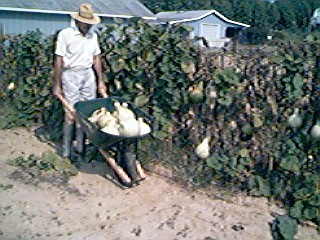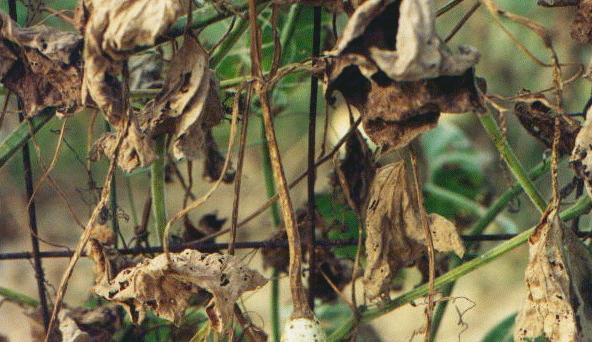Harvesting
Gourds

There are probably as many different methods for
harvesting gourds as there are people raising them. And, the type
you are growing, will depend on when and how you harvest them. If
you're growing the ornamental types, then you'll want these
harvested at the height of their color and definately before any
frost. These are usually the curcurbits. These little guys can't
take the cold like their bigger counterparts, the hard shelled
versions. They are grown for their aesthetic and artistic values and
have to be tended to when they are 'ripe'.
The larger hard
shelled gourds, however, are not harmed at all by cold and can sit
in the fields even through snow. But, for most of us though, we are
ready to get them in from the field as soon as they're done growing,
and for some reason, we want to get them drying off as soon as
possible, even though there's no hurry.
Now, in your digging
for information as to when to pick gourds, you've probably heard a
number of different things to do to harvest your gourds. Something
like "Let them sit on the vine until the first frost", or, "let them
sit in the field until dry", etc. That's great if you live where
there's frost. But, what if you live in the south like I do and
there isn't any frost until late in the year, or maybe not at all if
you live even further south. Well, here's what I've found that will
work for everybody regardless of where you live.
The best
time to harvest gourds is when they're done growing. And how can you
tell this? Simple. You can tell if a gourd is done growing by
looking at its stem. If it's started to shrivel, turn brown and dry,
then the gourd is done growing and is ready to harvest. This dried
stem means that the gourd is not receiving any more nutrients from
the vine, has been 'hardened off', and is ready to be harvested. To
do so, simply 'cut' the stem very close to the vine using a sharp
knife or trimming shears. Don't just twist it off. Leave as much of
the stem on the gourd as possible. For some reason, I've found that
cutting the stem too close to the gourd tends to aide in any
rotting, and besides, you may want to use the stem to hang them by
to dry.

Authors Note:
To be honest, I don't like to pick
my gourds any earlier than necessary. In fact, I leave them out in
the patch and just let everything die down. The vines and leaves
turn brown and die and the gourds are left just sitting in the patch
like a bunch of basketballs. They're very easy to see and I just
walk around with a pair of pruning sheers and snip them off next to
the vine and load them into my truck for transport back to my shop.
That's it. Nothing fancy. Once at my shop, I set them out on a
pallet or two until I am ready to proceed with getting them ready to
dry. The only thing here is to keep them off the ground so they can
get good air. Hopefully, it will rain so a lot or most of the
clinging debris will be removed before I have to handle them again.
In fact, they may end up sitting on this pallet until fully dry. It
doesn't hurt them and I have enough from last year, that I don't
need to rush to set them to dry.
How you harvest your gourds
is up to you and will depend on what type and how many you have. If
you have ornamentals, then a simple handbasket will do the trick. If
you grew bird house gourds and only have a few, then a simple lawn
cart or wheel barrow may do the trick. But if you have a large crop,
then you will probably have to use a truck or wagon of some sort to
collect them all. What ever the method, make sure they are not
excessively bumped and bounced against themselves or anything else
that will damage their skins.
The following are a few questions and answers
that you might run into with your gourds.
My gourds have
grown very large and I want to stop them at the size they're at.
If your gourds are extra large, and you think you may want
to stop them at the size they're at, then just cut them off and set
them aside to dry. Although this won't happen too often, it does
happen every now and then and you will have to cut them early to
stop them from becoming too large. Make sure you leave plenty of
stem. However, if at all possible, they should be left on the vine
until full maturity so they can be hardened off. Large 12" and 13"
gourds are loved by the purple martins.
I live in the
Northern part of the country and frost comes early. Do I need to
worry?
No. Frost does not affect mature lagenaria
gourds. A hard frost simply means that the vines are done growing
for the year. Often, the leaves may die, but the vines will still
deliver 'hardening off' nutrients to the gourds for some time later.
The gourds themselves, will not be affected at all. In fact, some
recommend leaving them in the field for curing. If this is done and
you have some beautiful big gourds, I would recommend putting
something like some straw or a board under the gourds so they don't
sit directly on the ground.
Will it hurt to handle my
gourds by the stems?
Not at all. The stems are very
strong and very capable of handling the weight of the gourd.
Remember, that's how the gourd hangs when it's growing. Now that
doesn't mean that they can be mishandled. One mistake and a stem
could come loose. You don't want to drop them. Ever seen a pumpkin
that was dropped? I like to pick my up by the stem, but then support
them with my other hand when moving them. The last thing I want to
do is accidentally drop a large beautiful gourd.
My gourds
seem to have tender skins and they bruise easily. How should I
handle them?
Green gourds have very tender skins and
should be handled with care. Try to not bang or bump them together
any more than absolutely necessary. Their skin bruises very easily
at this stage and if bruised too severely, they might not make it
through the drying process without getting infected and rotting.
Washing them in a weak bleach solution of 2 cups chlorine bleach and
5 gallons of water may help. Because their skins are so sensitive,
use a soft bristled brush to remove any excess field
debrie.
I'm going to make birdhouses with my gourds. Can I
do all the drilling, hole cutting and cleaning BEFORE putting them
up to dry?
NO! Although tender, the skin is a
protective device that protects the gourd while growing and later,
drying. Every scratch, mark or bruise that breaks that skin would
just be inviting infection into your gourd. Cutting a large hole
would simply be inviting trouble and probably render the gourd
useless. Besides, the gourds are very mushy at this stage and it
would be a very messy job to clean it out.
I've picked all
the usable gourds I want from my patch. What in the world do I do
with the rest of the smaller gourds and vines?
That
depends on what you plan to do with that area. If it's going to sit
there idle until next year, then don't do anything with the left
overs. The vines will simply dry up and rot. The smaller gourds
however could be dried and given to someone with some artistic
intentions and let them see what they can do with them. Also, the
smaller gourds could be used for bluebird or wren houses. If you
don't want to go through this trouble, then the little ones can be
smashed and left to rot along with the vines, otherwise, they will
dry right there in the field and you'll have a bunch of small dried
gourds come spring. When spring arrives, simply turn everything into
the soil so it's used as mulch for your new crop.
I have
to travel a long way to get my gourds home. Will it hurt to put them
in my truck transport them home?
Not at all. That's how I
bring mine home. I simply load them into the back of my truck and
I'm on my way. Just a few things. I make sure they are not free to
roll around. This can be accomplished by making sure you have a full
load or maybe adding a few boxes to take up some of the space. Add
some gourds in them to hold them down, and just drive carefully
until you get them where you're going.
Another thing you can
do is to 'pack them' so to speak with some straw. When you've picked
all the gourds and put them in the truck, add some straw in and
around the gourds so they can't roll around and get banged up.
A few more links on growing gourds
Growing Gourds By Jonathan R.
Schultheis, Extension Horticultural Specialist
Abby's Gourd Page Some gourd
information by Abby Lane
Comments/Questions
If you have any comments, would like to send me
another Martin site, or just say "Hi", please click on my
mail box to send e-mail to
Chuck Abare

Please note:
If you send me an Email and ask
a question and do not get an answer of some sort from me within a
couple of weeks, it's because your return email is not correct. Find
out what your correct email is, correct the problem and then send
your question to me again.
Back to the Gourd
Page
Back to Chuck's Purple Martin
Page
This page created
and maintained
by Chuck Abare

|
Woodside Gardens
The Registry of Nature Habitats  Copyright
Copyright  1999 -
All Rights Reserved 1999 -
All Rights Reserved
Last Updated:
| |

![]() Requirements for martins
Requirements for martins
![]() The Martin Bio
Page
The Martin Bio
Page![]() The Habits
Page
The Habits
Page![]() Tips to
Attract Them
Tips to
Attract Them ![]() Nest
Checks
Nest
Checks ![]() T-14
Mounting
T-14
Mounting![]() Purple Martin
Housing
Purple Martin
Housing 






 1999 -
All Rights Reserved
1999 -
All Rights Reserved